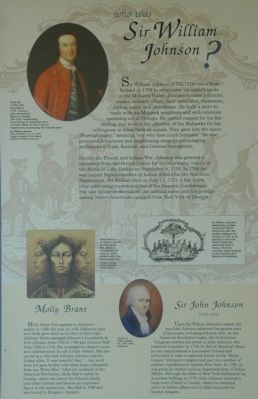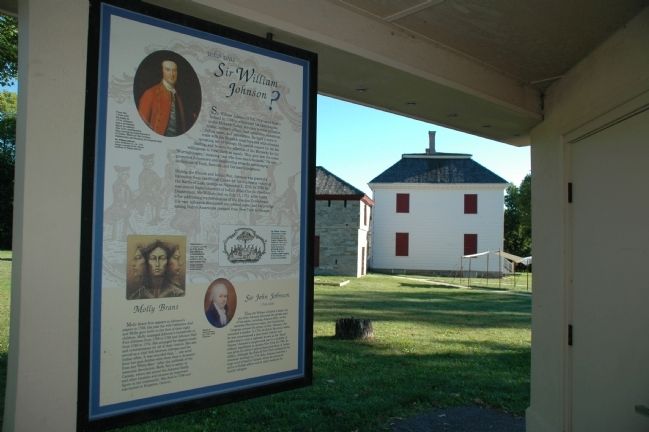Johnstown in Fulton County, New York — The American Northeast (Mid-Atlantic)
Who Was Sir William Johnson ?
During the French and Indian War, Johnson was granted a baronetcy from the British Crown for his impressive victory at the Battle of Lake George on September 8, 1755. In 1756 he was named Superintendent of Indian Affairs for the northern Department. Sir William died on July 11, 1774, a few hours after addressing representatives of the Iroquois Confederacy. His vast influence dominated the colonial scene, and his prestige among Native Americans spanned from New York to Georgia.
Molly Brant first appears in Johnson's papers in 1759, the year his wife Catherine died and Molly gave birth to the first of their eight children. Molly managed Johnson's households at Fort Johnson from 1759 to 1763 and Johnson Hall from 1763 to 1774. She arranged for elegant meals and entertainment for all of their visitors. She also served as a vital link between Johnson and his Indian allies. It was recorded that, "...one word from her goes farther with them than a thousand from any White Man." After the outbreak of the American Revolution, Molly fled to safety in Canada, where she joined the Johnson family and other loyalists and became an important figure in the community. She died in 1796 and was buried in Kingston, Ontario.
1742-1830
Upon Sir William Johnson's death, his son John Johnson inherited the greater part of his estate including Johnson Hall. As the American Revolution began, the Continental Congress ordered the arrest of John Johnson, who remained a loyalist. In 1776, he fled to Montreal where he was commissioned a Lieutenant Colonel and authorized to raise a regiment known as the "Royal Greens." Johnson's rangers took part in a number of military expeditions in upstate New York. In 1782, he was given his father's post as Superintendent of Indian Affairs. Although the State of New York confiscated his American holdings in 1779, Johnson received a large tract of land in Canada, where he remained active in Indian affairs and in relief measures for loyalist refugees.
[Photo Captions]
From
the 1740s until his death in 1774, Johnson was a prominent figure in colonial New York, representing King George as Superintendent of Indian Affairs for the Northern Department and Keeping the Iroquois Loyal.
Sir William Johnson, John Wollaston Jr., ca. 1751. Image courtesy of the Albany Institute of History and Art.
Sir William Johnson distributing medals among the native Americans after the English defeated the French in 1763, in an attempt to win over the Native Americans previously loyal to France. Note the covenant chain hanging in the branches as a symbol of friendship.
While there is no known portrait, this sketch is a composite of what the artist believes she may have looked like. Image courtesy of the Canadian Postal Service.
Sketch of John Johnson, ca. 1795. Artist Unknown.
Topics. This historical marker is listed in these topic lists: Native Americans • Patriots & Patriotism • Settlements & Settlers • War, US Revolutionary. A significant historical month for this entry is July 1882.
Location. 43° 0.952′ N, 74° 23.023′ W. Marker is in Johnstown, New York, in Fulton County. Marker can be reached from Hall Avenue, on the right when traveling west. The marker is mounted on a kiosk near the parking lot turn at the end of Hall Ave. at Johnson Hall State Historic Site. Touch for map . Marker is in this post office area: Johnstown NY 12095, United States of America. Touch for directions.
Other nearby markers. At least 8 other markers are within walking distance of this marker. Johnson Hall / The Landscape of Johnson Hall (a few steps from this marker); Johnson Hall State Historic Site (about 300 feet away, measured in a direct line); Johnson Hall 1762 (about 400 feet away); Landscaping Johnson Hall (approx. ¼ mile away); Johnson Hall (approx. 0.3 miles away); In Memory of Sir William Johnson, Baronet. (approx. 0.3 miles away); Battle Field (approx. 0.4 miles away); Site of Battle In American Revolution (approx. half a mile away). Touch for a list and map of all markers in Johnstown.
Also see . . . Johnson Hall National Historic Landmark - National Park Service. Download National Register of Historic Places documentation (Submitted on February 12, 2024, by Anton Schwarzmueller of Wilson, New York.)
Credits. This page was last revised on February 12, 2024. It was originally submitted on August 30, 2012, by Howard C. Ohlhous of Duanesburg, New York. This page has been viewed 556 times since then and 26 times this year. Photos: 1, 2. submitted on August 30, 2012, by Howard C. Ohlhous of Duanesburg, New York. • Bill Pfingsten was the editor who published this page.

